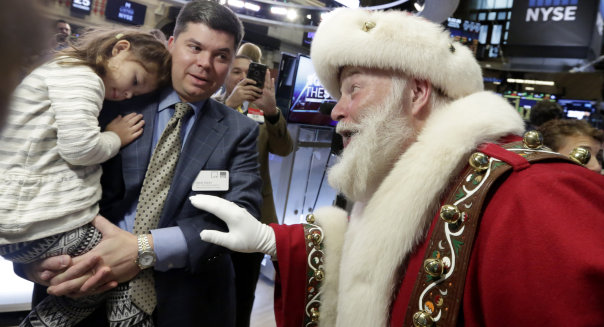
NEW YORK — The major U.S. indexes were virtually unchanged Wednesday at the close of a quiet trading day with gains in health care and consumer stocks after data showed U.S. modest economic growth.
Trading volume was low as many market participants were away in the last session before the U.S. Thanksgiving holiday. Markets will be closed Thursday and most of Friday afternoon.
The news this morning was a little better than worse, so the market went up.
“The news this morning was a little better than worse, so the market went up,” said Peter Costa, president of Empire Executions, citing mixed economic data.
The Dow Jones industrial average (^DJI) rose 1.2 points, or 0.01 percent, to 17,813.39, the Standard & Poor’s 500 index (^GSPC) lost 0.27 points, or 0.01 percent, to 2,088.87 and the Nasdaq composite (^IXIC) added 13.34 points, or 0.3 percent, to 5,116.14.
Data showed claims for jobless benefits fell more than expected to 260,000 last week, while durable goods orders for October, excluding aircraft, increased 1.3 percent, far more than the 0.4 percent expected.
However, other reports suggested consumers weren’t in a spending mood, with consumer spending increasing just 0.1 percent in October compared with the 0.3 percent expected.
The University of Michigan’s final index of consumer sentiment for November also fell short of estimates.
While investors cited good conditions for consumers, they were cautious about global security issues and the impact from the first U.S. interest rate hike since 2006, which is widely expected to happen in December.
“With market valuations where they’re at right now, there’s potential downside if the next data point or global political event is negative,” said Jeff Morris, head of U.S. equities at Standard Life Investments in Boston.
‘Swing Factor’
Traders turned their focus to the crucial U.S. holiday shopping season, which starts around Thanksgiving.
“That’s going to be the key, the swing factor for the next couple of weeks — how holiday sales shape up,” said Michael Baele, senior portfolio manager at U.S. Bank Private Client Reserve in Portland, Oregon.
“When you consider the job market, low energy costs [and] low interest rates, the consumer’s in pretty good shape.”
Four of the 10 major S&P sectors were higher, with gains in the health care and consumer discretionary sectors leading the way, while the energy and utilities sectors were lower.
HP Inc. (HPQ), the new company that houses the former Hewlett-Packard’s printer and PC businesses, dropped 13.7 percent after its profit forecast missed estimates.
Hewlett-Packard Enterprise (HPE), HP’s corporate hardware and services businesses, rose 3 percent after it maintained its full-year profit forecast.
NYSE advancing issues outnumbered decliners 1,852 to 1,185, for a 1.56-to-1 ratio on the upside; on the Nasdaq, 1,853 issues rose and 947 fell for a 1.96-to-1 ratio favoring advancers.
The S&P 500 posted 17 new 52-week highs and no new lows; the Nasdaq recorded 91 new highs and 42 new lows. Just under 5.2 million shares changed hands Wednesday on U.S. exchanges, well below the 7.19 billion average for the last 20 sessions.
-.
What to watch Thursday: U.S. financial markets are closed for Thanksgiving.
•Wall Street Rallies on Fed Rate Hike
•Fed Raises Interest Rates, Cites Ongoing US Economic Recovery
•US Aerospace Sector Poised for 2015 Record Trade Surplus: Group


Leave a Reply